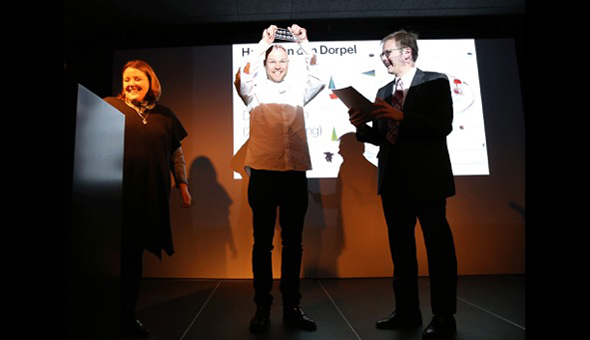Net-based prize 2016 winners: Harm van den Dorpel with Deli Near Info, and Christoph Wachter and Mathias Jud with Can You Hear Me?
HeK (House of Electronic Arts Basel)
Freilager-Platz 9
4142 Münchenstein/Basel
Switzerland
hek.ch
Facebook / Twitter / Instagram
This weekend, the HeK (House for Electronic Arts) held the net-based award ceremony for the first time. This new Swiss prize aims to draw more attention to the Internet as a platform for artistic activities. It wishes to make innovative web-based projects—including works from the Swiss scene—accessible to a broader public and to simultaneously foster international exchanges on the topic.
More than 200 outstanding submissions were reviewed by an international jury: Karen Archey (freelance curator and art critic, Berlin/New York), Ben Vickers (digital art curator, Serpentine Galleries, London), Raffael Dörig (director Kunsthaus Langenthal), Sabine Himmelsbach (director HeK, Basel) and Felix Stalder (cultural theorist, Switzerland). A shortlist of 10 works had been selected and was presented during the award ceremony.
It is our pleasure to announce that two exceptional winners received the net-based prize this weekend: Harm van den Dorpel with Deli Near Info (2014–ongoing) and Christoph Wachter and Mathias Jud with Can you hear me? (2014).
Born 1981 in the Netherlands where he studied both Artificial Intelligence and Time-Based Arts, Harm van den Dorpel now lives and works in Berlin. The artist often refers to his belief that every kind of conclusion is problematic, and announces the immediate death of the fixed object. He chooses as support the Internet, which contrastingly lives as an ecosystem of live interacting objects.
Along with earlier works, Deli Near Info focusses on understanding and generating processes linked to cognitive “relevance.” It presents a social network elevated to the level of conceptual artwork: by regularly using the platform, the latter learns to arrange text and images in non-linear associations. As such, the work challenges the structure of corporate social networks, offering an alternative to their linearity. A point is made that these online environments are normally highly constructed, thus influencing our thought patterns; they are charged political spaces, whose very infrastructure we should be more critical about.
Christoph Wachter & Mathias Jud, both Zürich born artists, are currently based in Berlin. Together, they have worked towards highlighting forms of internet and media censorship, surveillance, etc.—for instance, assembling images of restricted military zones and creating 3D virtual walkthroughs with Zone*Interdite (2000–ongoing).
In Can You Hear Me?, they question the underlying infrastructure of digital spaces. At the Swiss embassy in Berlin, they set up a Mesh-Network allowing anonymous communication. In a space highly monitored by intelligence offices, they created room for exchange where, for example, anonymous messages can be sent to the NSA. Their artistic strategy is remarkable in that it develops awareness of the dependencies and regularities of a globally interconnected world.
Finally, the voters chose to award the audience prize to Julia Weist’s Reach (2015–16). A librarian and neo-conceptual artist, Weist came across across the term “parbunkells” in a 17th century publication from the New York Public Library. At the time, Weist remarked that it did not have one single online entry supported by existing search-engines. In June 2015, this prompted the launch of what almost appears to be an advertising campaign “selling” the word to the masses. Printed and displayed in a gigantic billboard in Queens (NY), the work initiated thousands of public reactions, unprecedentedly boosting the online presence of the term. With this work in the form of an advertising gimmick, Weist raises questions about public engagement as well as about the commercial potential and freshness of a blank canvas on the net.
